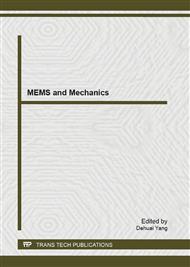[1]
H. Murata, K. Fujiyoshi, S. Nakatake, and Y. Kajitani, "VLSI module placement based on rectangle-packing by the sequence-pair," IEEE Trans. Comput. Aided Design, vol. 15, pp.1518-1524, Dec. 1996.
DOI: 10.1109/43.552084
Google Scholar
[2]
K. Sakanushi, Y. Kajitani and D. P. Mehta, "The Quarter-State-Sequence Floorplan Representation," IEEE Trans. Circuits and Systems, vol.50, pp.376-386, March, 2003.
DOI: 10.1109/tcsi.2003.809442
Google Scholar
[3]
X. Hong, G. Huang, Y. Cai, J. Gu, S. Dong, C.-K. Cheng, and J. Gu, "Corner block list: an effective and efficient topological representation of nonslicing floorplan," in Proc. IEEE/ACM Int. Conf. Computer-Aided Design, 2000, pp.8-12.
DOI: 10.1109/iccad.2000.896442
Google Scholar
[4]
Xuliang Zhang, Yoji Kajitani, "Theory of T-junction floorplans in terms of single-sequence." ISCAS (5) 2004: 341-344.
DOI: 10.1109/iscas.2004.1329532
Google Scholar
[5]
H.A. Zhao, C. Liu, Y. Kajitani and K. Sakanushi, "EQ-Sequences for Coding Floorplan," EICE Trans. Fundamentals. Vol. E87-A, No. 12, pp.3233-3243, 2004.
Google Scholar
[6]
X. Zhang and Y. Kajitani, Space-planning: placement of modules with controlled empty area by single- sequence, Proc. Asia and South Pacific Design Automation Conf., p.25–30, Japan.
DOI: 10.1109/aspdac.2004.1337534
Google Scholar
[7]
M. R. Kramer and J. van Leeuwen. "The complexity of wire routing and finding minimum area layouts for arbitrary VLSI circuits." In F. P. Preparata, editor, Advances in computing research, volume 2: VLSI theory, pages 129–146. JAI, Reading, MA, 1984.
Google Scholar
[8]
A. B. Kahng and G. Robins, "On optimal interconnections for VLSI," Kluwer Academic Publishers, Boston, MA, 1995.
Google Scholar
[9]
J. Hu and S. S. Sapatnekar, "A Survey on Multi-net Global Routing for Integrated Circuits," Integration: The VLSI Journal, Vol. 31, No. 1, p.1 – 49, November 2001.
DOI: 10.1016/s0167-9260(01)00020-7
Google Scholar
[10]
H.A Zhao, Z. Yang, T. Mihara, etc, "VLSI Floorplanning with Boundary Constraints using Genetic Algorithms," Advances in Natural Computation and Data Mining, pp.59-68, 2006.
Google Scholar
[11]
C. Albrecht. Global routing by new approximation algorithms for multicommodity flow. IEEE Trans. On Computer-Aided Design of Integrated Circuits and Systems, 20(5):622–631, May 2001.
DOI: 10.1109/43.920691
Google Scholar
[12]
M. Borah, R. M. Owens, and M. J. Irwin. An edge-based heuristic for Steiner routing. IEEE Trans. on Computer-Aided Design of Integrated Circuits and Systems, 13(12):1563–1568, December 1994.
DOI: 10.1109/43.331412
Google Scholar


